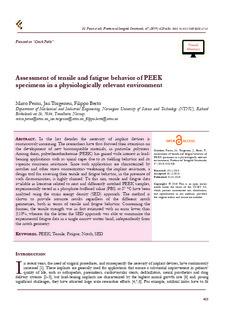| dc.contributor.author | Peron, Mirco | |
| dc.contributor.author | Torgersen, Jan | |
| dc.contributor.author | Berto, Filippo | |
| dc.date.accessioned | 2020-02-13T07:58:36Z | |
| dc.date.available | 2020-02-13T07:58:36Z | |
| dc.date.created | 2019-04-11T20:15:27Z | |
| dc.date.issued | 2019 | |
| dc.identifier.citation | Frattura ed Integrità Strutturale. 2019, 13 (47), 425-436. | nb_NO |
| dc.identifier.issn | 1971-8993 | |
| dc.identifier.uri | http://hdl.handle.net/11250/2641442 | |
| dc.description.abstract | In the last decades the necessity of implant devices is continuously increasing. The researchers have thus focused their attentions on the development of new biocompatible materials, in particular polymers. Among them, polyetheretherketone (PEEK) has gained wide interest in load-bearing applications such as spinal cages due to its yielding behavior and its superior corrosion resistance. Since such applications are characterized by notches and other stress concentrators weakening the implant resistance, a design tool for assessing their tensile and fatigue behavior in the presence of such discontinuities is highly claimed. To this aim, tensile and fatigue data available in literature of neat and differently notched PEEK samples (circumferentially cracked and U-notched specimens with different notch radii) experimentally tested in a phosphate-buffered saline (PBS) at 37 °C have been analyzed using the strain energy density (SED) approach. The method is shown to provide accurate results regardless of the different notch geometries, both for tensile and fatigue data. Concerning the former, the tensile strength was in fact estimated with an error lower than ±10%, regardless of the strain rate, while for the latter the SED approach was able to summarize the fatigue data with a single narrow scatter band independently from the notch geometry | nb_NO |
| dc.language.iso | eng | nb_NO |
| dc.publisher | Gruppo Italiano Frattura | nb_NO |
| dc.rights | Navngivelse 4.0 Internasjonal | * |
| dc.rights.uri | http://creativecommons.org/licenses/by/4.0/deed.no | * |
| dc.title | Assessment of tensile and fatigue behavior of PEEK specimens in a physiologically relevant environment | nb_NO |
| dc.type | Journal article | nb_NO |
| dc.type | Peer reviewed | nb_NO |
| dc.description.version | publishedVersion | nb_NO |
| dc.source.pagenumber | 425-436 | nb_NO |
| dc.source.volume | 13 | nb_NO |
| dc.source.journal | Frattura ed Integrità Strutturale | nb_NO |
| dc.source.issue | 47 | nb_NO |
| dc.identifier.doi | 10.3221/IGF-ESIS.47.33 | |
| dc.identifier.cristin | 1691808 | |
| dc.description.localcode | © 2019 This is an open access article under the terms of the CC-BY 4.0, which permits unrestricted use, distribution, and reproduction in any medium, provided the original author and source are credited. | nb_NO |
| cristin.unitcode | 194,64,92,0 | |
| cristin.unitname | Institutt for maskinteknikk og produksjon | |
| cristin.ispublished | true | |
| cristin.fulltext | original | |
| cristin.qualitycode | 1 | |

